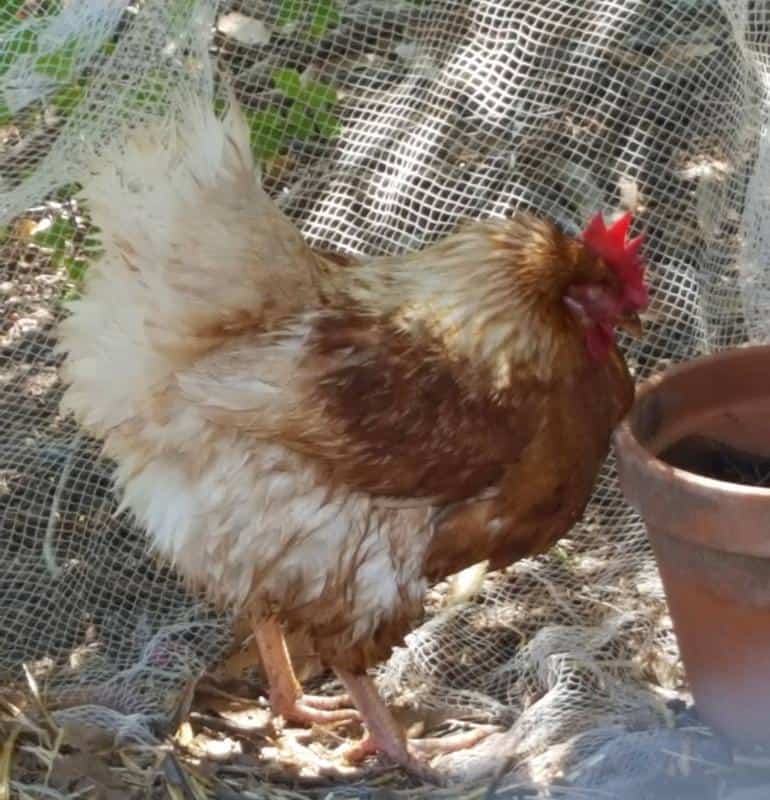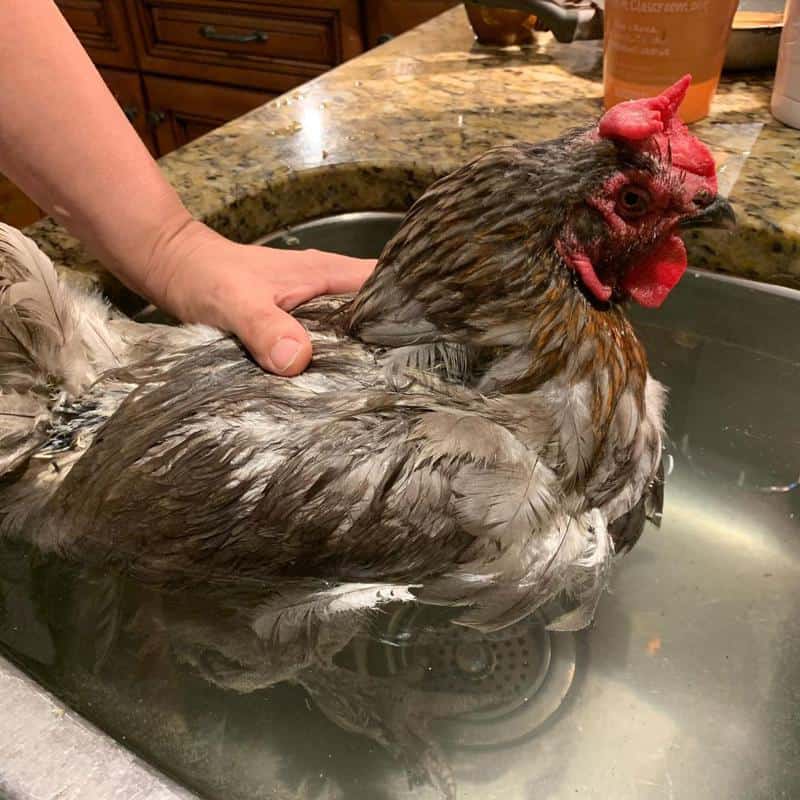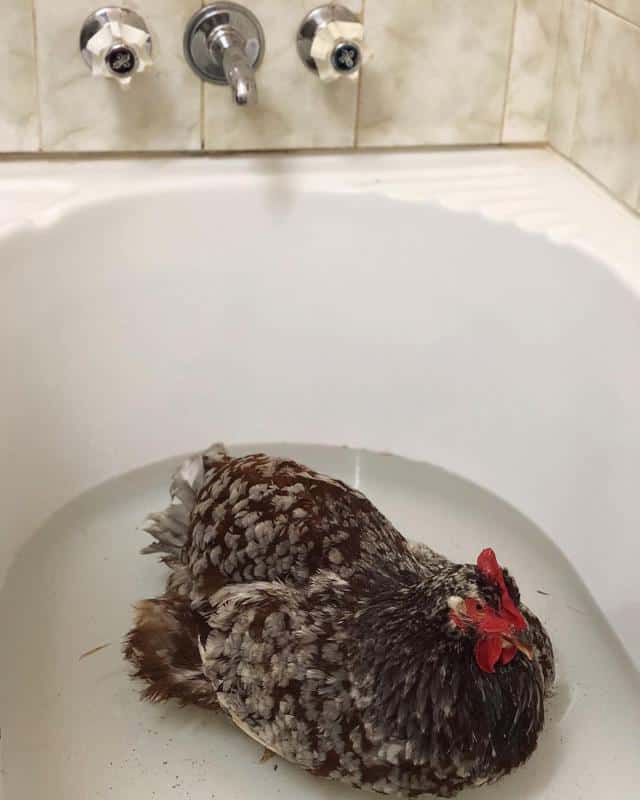Picture this: As you stroll around observing your chatty free rangers go about their day, an unconventional scene captures your attention. One of the chickens is distressing and waddling like a penguin. After waddling, the chicken stands legs apart, squats, and pumps its tail.
These are clear signs of an egg-bound chicken crying out for help.
An egg-bound chicken refers to a hen with an egg stuck along its oviduct. The egg is usually a few inches from being passed out, but due to some reasons, the hen cannot lay it.

If not addressed immediately, this life-threatening condition can claim your bird’s life within 24-48 hours.
While no chicken breed is immune to egg binding, it’s most common in female birds not exposed to a mate.
Funny enough, some chickens can hide the symptoms of this condition, making it hard to know if they’re sick.
But with the help of this guide, you will learn everything about egg binding in chickens, from its causes to treatment.
What are you waiting for? Let’s dive in!
How Does Egg Binding Come About?
The journey of an egg starts from the ovary as the reproductive cells merge. After merging, the egg’s development begins and continues as it moves down the oviduct and into the shell gland.
A greater chunk of the egg’s development occurs in the shell gland. The egg spends about 18 to 24 hours in the shell gland as specialized cells deposit calcium carbonate and other minerals to form the eggshell. Color pigments are also deposited onto the egg while in the gland.
Once the egg is fully developed, the oviduct muscles turn the egg to ensure the blunt side points toward the oviduct’s opening, the cloaca.
If the muscles do not complete this maneuver, the egg might get stuck in the reproductive system, causing the chicken to become egg-bound. Sometimes, the egg may be in the right position, only for the chicken to lack the strength to push it out.
But it’s not all about strength! Other factors that can lead to egg binding in chicken include:
1. Low Calcium Count
By now, you know chickens need calcium to develop strong bones and eggshells. But the role of this mineral extends past these functions. Calcium also facilitates muscle function, such that it helps the hen push the egg out.
If a hen has low calcium levels, it can be dangerous because her muscles won’t have enough energy to push the egg out.
2. Reproductive Tract Infections
The chicken’s oviduct might host bacteria and pathogens, causing infections like Salpingitis.
Salpingitis affects the oviduct, building up blockages and scarring it. This makes it difficult for the chicken to lay eggs usually.
3. Obesity
Yes! Chickens can become obese? This usually happens when the birds accumulate excess fats, leading to weight gain.
The fat tends to accumulate along the reproduction system, which causes weakening of the oviduct. When this happens, the hen might struggle to expel the egg.
Excess body weight can also cause nutritional deficiencies, like reduced calcium levels, affecting the shell’s quality and size.
Moreover, more fatty tissues around the respiratory system reduce lung capacity, decreasing the hen’s tolerance for physical activity. The weaker the chicken gets, the higher the risk of egg binding.
4. Stress
Several actions, for example, moving a chicken to a new coop, rearranging the objects within its space, or introducing it to a new flock, can stress the bird. The same rings true for sudden dietary changes.
The more stressed the chicken, the higher the likelihood of egg binding. But how?
Stress disrupts the normal egg development process, plus affects the oviduct contraction. To top it all off, it can lead to nutritional deficiencies or parasite infections, and these contribute to egg bidding.
5. Misshapen Eggs
If a chicken lays huge or malformed eggs, it will probably be egg-bound. The chicken spends more energy and time expelling the egg. This makes the chicken tired and unable to complete the task.
6. Worms
Worms increase the likelihood of egg binding because they feed on the nutrients meant for the chicken. These parasites weaken birds by affecting their ability to absorb essential nutrients like calcium, making them egg-bound.
7. Egg Retention
Some chickens deliberately hold on to an egg whenever they feel like there is no nesting area. The longer you delay preparing them a nesting box, the more tired their muscles become. Eventually, the hen gets egg-bound.
8. Premature Laying
Some people try to force pullets to lay eggs artificially by manipulating factors that influence egg production. But doing so will only harm your girl’s health, leading to issues like egg binding.
Remember, as pullets, chickens have undeveloped reproductive muscles. So, they don’t have enough strength or energy to push the egg out of the cloaca.
But don’t worry, there’s a safe way to encourage your pullets to lay eggs!
Start by providing them with well-balanced and nutritious feeds. Also, ensure your chatty friends have access to clean water every time.
Don’t forget to provide them with enough nesting boxes and roosting space, too.
Egg Bound Chicken Symptoms

Now that you understand the causes of egg-binding, it’s high time you learn about its symptoms.
As said earlier, chickens rarely show signs of ailments, as they might get bullied, pecked at, or isolated from the flock. For this reason, it might be hard to tell if a chicken is egg-bound, especially for novice farmers.
Fortunately, there are some obvious clinical signs and symptoms for this condition, including:
1. Waddling Like a Penguin
The pain, stress, and discomfort caused by the obstructed egg often cause the chicken to assume a penguin-like walking style.
2. Tail Pumping
Another clear sign of egg-binding in chickens is tail pumping. The hen stands with its legs apart, squats close to the surface, and pumps its tail up and down, trying to drop the egg.
3. Uncontrollable Shaking
Sometimes, the chicken would put in a lot of work to get rid of the bound egg, pushing its muscles to the limit. The more the muscles work, the weaker the chicken becomes, making it shake uncontrollably.
4. Reduced Appetite
An egg-bound chicken avoids hydrating and eats less. Some chickens might reduce their food portion or stop eating altogether. If a chicken does this for more than 24 hours, be alarmed and take action.
5. Pooping Less
When an egg is lodged inside the oviduct, it presses against the intestinal tract, obstructing the normal flow of waste out of the system. As a result, the chicken might have trouble passing out solid waste.
With some struggle, the chicken might pass out watery diarrhea with an offensive smell. You will also notice the hen will have a full crop.
6. Looking Lethargic and Sitting Frequently
A chicken might get lethargic after pushing the obstructed egg for an extended period. She will become visibly sluggish, tired, and lack the energy to keep her eyes open. These can also be signs of stress or depression caused by other factors.
How to Help an Egg-Bound Chicken

If you notice the symptoms above in your hen, it’s critical to act quickly since egg-binding is a life-threatening condition.
But before dealing with it, you might need to collect a few items…
- Vegetable oil or petroleum jelly, preferably Vaseline
- Epsom salts
- Latex gloves
- Water–at least a gallon
- Source of heat such as an electric kettle or hot shower
- A large needle
- A 20ml syringe
- A large pair of tweezers
Once you have everything, follow the steps below:
Approach One
Ascertain If the Chicken Is Egg-Bound
Sometimes, a chicken might have all the symptoms mentioned earlier, only for you to realize it is not egg-bound.
But the good news is there’s an easy way to determine if your hen is egg-bound. Separate the ailing hen from the flock members.
Put on the latex glove and lubricate your index finger with either vegetable oil or petroleum jelly. Do this to avoid damaging or tearing the hen’s delicate vent.
Pick the chicken up and place it under your arm, facing backward. Deep your index finger gently into the chicken’s cloaca to about 2 inches.
If the vent is not blocked by an egg, the hen may have egg peritonitis or cystic right oviduct, which have similar symptoms to egg-binding.
But if you feel an egg, move to the next step.
Soak The Chicken’s Vent Area and Abdomen

Heat about ½ of a gallon of water and pour into a tub or huge basin, then add about ½ cup of Epsom salts.
Make sure the water cools down to avoid burning the chicken’s skin. Gently lower the chicken into the water to soak its abdomen and vent area.
Keep the chicken calm and comfortable to avoid breaking the lodged egg. At first, the chicken might struggle, but eventually, she will get used to the water and settle down.
Let the bird sit in the tub for about 20 to 30 minutes. The warm water will help sooth the hen’s exhausted muscles, allowing her to relax. Pet the chicken to keep it calm and still.
Also Read: Can Chickens Swim?
Keep The Chicken in A Quiet Place to Allow It to Lay the Egg
After the soaking period, dry the chicken and allow it time to lay the egg. Place her in a quiet, dark area with little traffic.
It also helps to line her vent with vegetable oil or petroleum jelly, which acts as lubricants, helping the egg slide out.
If the chicken does not lay the egg in an hour, soak it in warm water again. You can also help the chicken by carefully massaging its abdomen area. If this does not work, you might be forced to dislodge the egg piece by piece.
Approach Two
If the chicken lays no egg after 2 to 3 baths, you might be forced to go in like a surgeon and take the egg out piece by piece. But we generally recommend against this method because you might injure your bird. You may also make it susceptible to infections.
To physically remove the egg, find someone to hold the chicken still for you. Next, use a needle to make a hole in the eggshell, then remove it.
Place the syringe head at the hole and suck out the egg’s content. After that, slightly enlarge the hole and use a pair of tweezers to remove the fragments of the shell piece by piece.
If you accidentally left some pieces in the chicken’s vent, they will likely come out after some days. But it doesn’t hurt to reach out to your local vet for further advice.
How to Prevent Egg Binding
- Provide your chicken with the correct amount of nutrients, especially calcium and vitamin D. The stronger and healthier your chicken, the less it will fall victim to egg binding.
- Control internal parasitic worms and check for any other infections. Have your vet examine the chickens regularly.
- Avoid keeping your chicken waiting for a new nesting box. This forces them to keep an egg for long, increasing the possibility of egg binding.
- Remove all elements of stress. If you want to change their meal, nesting area, or flock members, do so progressively. This way, they’ll have enough time to adapt.
- Avoid exposing your pullets to conditions that might lead to premature egg laying.
- If a hen is known for laying large or misshapen eggs, keep an eye on her to prevent cases of egg binding or seek the vet’s advice.
Read More: Chickens Laying Soft Eggs
Take Away
Most egg-bound chickens have anywhere from 24 to 48 hours to live. Therefore, it’s crucial to address this condition immediately after you identify it.
As seen above, egg-binding in chickens can occur due to various reasons like poor nutrition, stress, and infections. Chickens with these conditions may show symptoms like tail pumping and waddling.
Luckily, egg-binding can be prevented, provided you give your flock a balanced diet and a clean place to sleep and reduce potential stressors.
Remember, your birds depend on you for their survival and happiness. So, do your best to ensure they stay in tip-top condition.
